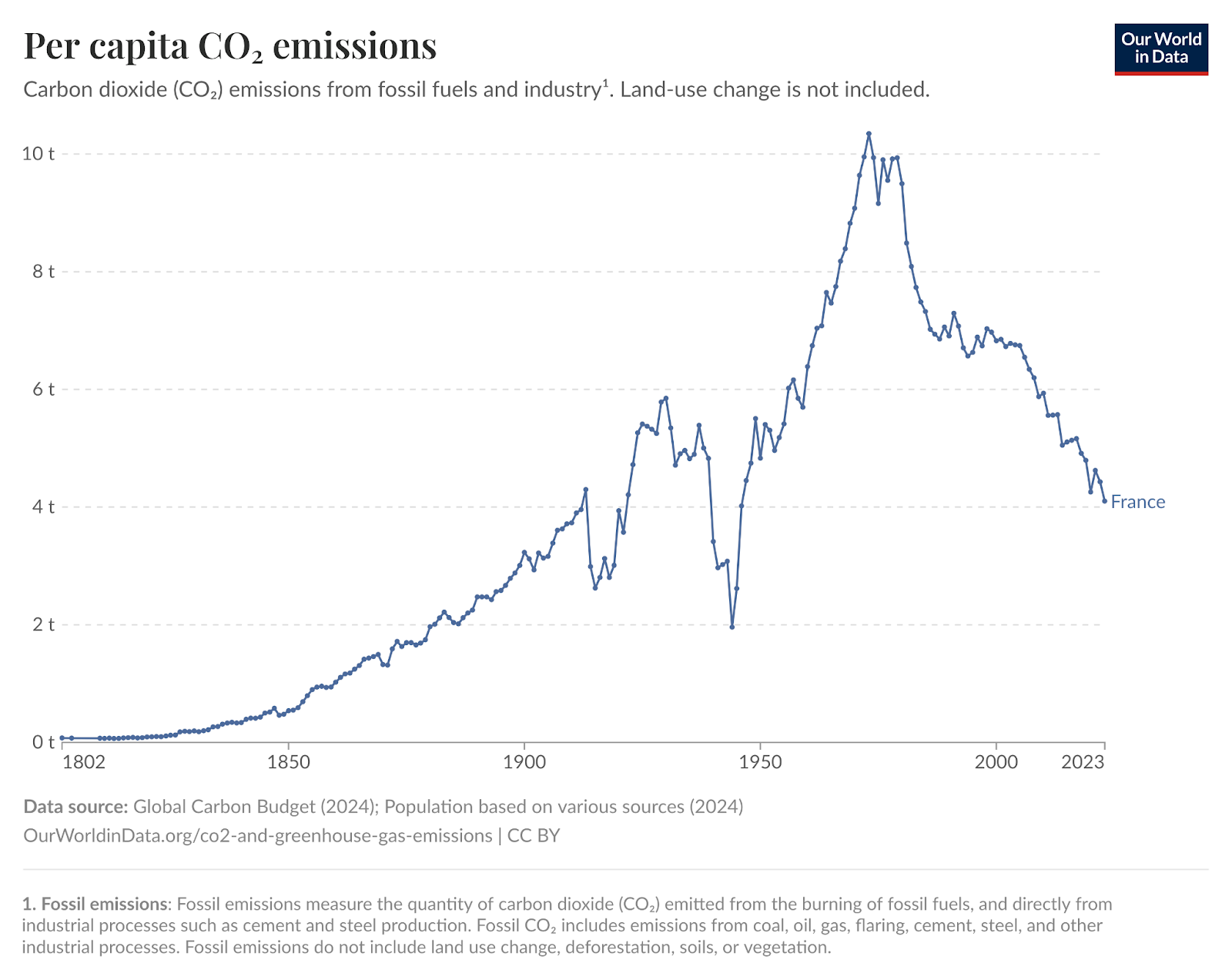Imagine a very different 2025.
You can hop on a supersonic plane and get from New York to Los Angeles in 30 minutes or from New York to Japan in two hours instead of 20. We’ve got tremendous energy abundance with cheap, clean nuclear energy and sweeping fields of solar cells with batteries. There is no climate crisis or activists gluing themselves to famous paintings.
Robotic factories build everything from toys to advanced microchips. Machine learning solved protein folding 20 years earlier and powered a medical revolution, with permanent CRISPR cures for cystic fibrosis and sickle cell anemia. Stem cell therapies for damaged hearts came a decade earlier, saving tens of millions of people from early death. Nanotech robots eat arterial plaque, and we have mRNA cures for HIV, Zika, breast and prostate cancer.
A grid of seventh-generation Starlink satellites beams down InfiniBand-speed internet across the globe. Using a robot and lag-free, ultra-high-definition VR, a top doctor in New York can now perform life-saving surgery on a patient halfway across the world.
How did we get to this sci-fi future decades early? In the years leading up to it, the Luddites and other enemies of innovation failed at every attempt to cripple, crush, or kill progress.
In the world of flight, there was no backlash against “sonic booms” or runaway fears after the Concord explosion. Instead, engineers did with supersonic jets what they’ve done with every other kind of plane: they made them safer. In 2022, there was just one airplane passenger injury for every 15 billion miles flown, and supersonic jets could be just as safe — but much faster.
Anti-nuclear activists didn’t kill nuclear expansion in the 1970s. Instead, the US kept right on building reactors, leading to a carbon emissions chart like France’s. We have safe, clean, abundant energy, and there’s no talk of degrowth or slowing down — just what to build next.
The US didn’t pull funding for stem cells during the Bush administration, and in Africa and Asia, widespread technophobia didn’t prevent the approval of genetically modified crops that could save the vision — and lives — of millions of the continents’ most-vulnerable residents.
Unfortunately, that’s not the world we got. So, what went wrong?
The answer is that, in way too many cases, the Luddites won. They slammed the brakes on technology and progress out of unfounded fears or personal beliefs, and we all paid the price.
Activists push big, scary headlines about the bad things they predict a technology will bring, but they ignore the good things we stand to lose without the technology.
The hidden price of technophobia is incredibly high, too. The real cost of these doomsday policies is in the air we breathe, the families who bury loved ones too soon, the new kinds of jobs that never get created, and the rockets that never blast off.
Activists push big, scary headlines about the bad things they predict a technology will bring: a silent spring, mass unemployment, a new ice age. But they ignore the good things we stand to lose without the technology: the jobs that never get created, the clean air we don’t breathe, the cascade of new inventions that never come to be.
When you throw a wrench in the wheels of progress, an alternative future full of opportunities disappears. Enemies of innovation may think they’re doing the right thing by slowing progress down, but they too often fail to consider how gumming up the works causes us to miss out on good things.
What diseases will we cure with stem cell breakthroughs decades later than we could have because we wasted eight years in the second Bush administration restricting the research? How many damaged lungs did we get because we killed off nuclear and kept right on burning coal to keep up with electricity demand?
Opportunity cost is invisible — but as we’ve seen time and again, it’s one of the biggest bills in history.
The clean energy future we regulated away
In 2013, researchers from NASA and Columbia University calculated that America’s nuclear power fleet had prevented 1.8 million premature deaths and 64 gigatonnes of CO2-equivalent greenhouse gas emissions since 1971.
Now imagine if the US had doubled or tripled the size of its reactor fleet since the 1970s.
By 2025, it would be running on a French‑style nuclear grid, with more than 70% of its electricity generated from zero‑carbon fission. We would have prevented another two to four million deaths. Instead of rising, global temperatures would have stayed steady. In short, there’d be no climate crisis.

Here’s what happened instead.
Protests against nuclear power intensified in the 1960s and ‘70s. In 1974, the US scrapped the Atomic Energy Commission, which was tasked with both regulating and promoting nuclear energy, and replaced it with the practically anti-nuclear Nuclear Regulatory Commission (NRC).
The NRC prioritized minimizing risk over promoting growth, creating regulatory roadblocks that made it harder to build nuclear reactors. The US didn’t break ground on a single new reactor between 1977 and 2013, and the first reactor of the modern era didn’t go online until 2023. Two of the four projects launched in the past 12 years were abandoned before completion.
Why did this happen? Because humans are great at overestimating big, flashy, short-term threats and ignoring long-term ones. Smoking might cause lung cancer, but because it takes decades to develop, it’s easy for people to continue to puff away on their cigarettes. Get one painful but temporary sunburn, though, and you’re unlikely to forget to slather yourself in sunscreen the next time you hit the beach.
In 1979, a nuclear reactor at Three Mile Island power plant in Pennsylvania experienced a partial meltdown. No one died during the accident, and people living in the area experienced a dose of radiation “about 1 millirem above the usual natural background dose,” according to the NRC — that’s not much higher than a chest X-ray.
Still, that accident became the rallying cry for the anti-nuclear movement and helped put nuclear builds on ice for 46 years. While nuclear regulators fought over paperwork, coal plants kept belching poison. Fewer than 2,800 people have died due to nuclear energy, but pollution from fossil fuel-generated electricity now kills 1.1 million to 2.55 million people every year
Aside from its direct impact on our health, this continued reliance on fossil fuels is warming the planet — ironic, given that environmentalists were at the forefront of the early anti-nuclear movement.
Eight years in the stem cell wilderness
Heart damage is permanent. We can’t heal scar tissue or naturally regrow injured heart muscle. If heart damage is severe, a person’s only hope of survival is a transplant, and there aren’t enough donor hearts available to meet demand.
Imagine if we could repair heart damage, though. We could potentially save some of the estimated 17.9 million people who die of heart disease every year.
Stem cells could make this a reality.
Most of the cells in your body are specialized to serve a very specific role. Stem cells have yet to develop into a specific type of cell, and by creating the right conditions around them, scientists can turn these cells into whatever your body needs — including new heart tissue.
Attempts to do this are already underway. In 2024, a University of Illinois cardiologist launched a clinical trial testing whether stem cells derived from umbilical cords and delivered intravenously could help patients with chronic heart failure — something that had never before been tested in the US.
That stem cell treatment of tomorrow could join the several we already have today — across the globe, these powerful cells are being used to repair broken bones, cure sickle cell anemia, and treat cancers, such as leukemia.
It could have happened a lot faster, though.
In science, every lost year compounds.
In August 2001, then-US President George W. Bush froze federal funding for embryonic stem cell lines, largely due to activists’ moral and ethical concerns about the destruction of human embryos.
Overnight, America’s most promising biologists became policy refugees. Labs shuttered or limped along on private grants. Many simply moved to Singapore or the UK. California tried to fill the funding void by setting aside a $3 billion bond for stem cell research in 2004, but state-level action can’t replace a coordinated federal effort to advance a field.
The federal embargo ended in 2009, but in science, every lost year compounds: you start with fewer post‑docs trained, and that leads to fewer papers published and cited, fewer startups spun out, and fewer breakthroughs built atop those that came before.
A paper published in the journal of Technology and Innovation in 2011 estimated that the moratorium delayed first‑in‑human stem cell therapies for macular degeneration and Type 1 diabetes by at least five years, affecting countless patients who could have regained their eyesight or thrown away their insulin pumps earlier.
Ultimately, the philosophical concerns of anti-stem cell activists created an unmarked graveyard filled with treatments for innumerable ailments, from heart disease to cancer. We may still get some of them, but every year lost is another year delayed.
The empty fields of Africa and Asia
Using advanced gene-editing technologies, we now have the ability to modify crops to give them desirable characteristics, and according to the vast majority of scientists, these genetically modified organisms are perfectly safe to eat.
“[T]here have been no confirmed incidents of adverse human health or environmental effects from genetically engineered crops during nearly three decades of global use,” wrote an international team of food scientists in 2021.
In 1999, two European scientists, Ingo Potrykus and Peter Beyer, produced a prototype of a rice plant that had been genetically modified to help address vitamin A deficiency, which is a leading cause of childhood blindness — every year, it strips vision from half a million children, many of whom live in Africa.
By 2005, their “Golden Rice” had been developed to the point that it could have a real impact on public health, but despite no credible trials suggesting that it wasn’t safe to eat, anti-GMO activists would oppose the crop and slow the approval process to a crawl.
In 2021, the Philippines would become the first nation to approve Golden Rice for cultivation on a commercial scale, but just three years later, it rolled back the approval “out of caution.” Again, this blow to progress was dealt by people with unfounded fears of “Frankenfoods.”
Activists trumpet the possibility of hypothetical risks while ignoring the certainty of hungry kids.
Golden Rice isn’t an anomaly, either.
The bacterial disease banana xanthomonas wilt (BXW) is a massive problem for farmers across Africa, costing them both lives and livelihoods. It slashes yields and sometimes kills as much as 100% of a farmer’s crop. Scientists have created multiple GMO bananas that are resistant to the disease, but regulators have yet to clear any of them.
Genome‑editing could double smallholder yields and erase entire pesticide classes, but smart bills to intelligently regulate GMO crops get stuck in endless back and forth battles. A disease-resistant cassava in Kenya, a vitamin-A-fortified banana in Uganda, a blight-resistant potato in Nigeria — each sits in a regulatory holding pattern while real people skip meals. (Though in a recent glimmer of hope, Nigeria did make some progress with the late-2019 approval of pod borer resistant cowpeas.)
According to a paper published in Frontiers in Bioengineering and Biotech, this is largely due to Africans’ ingrained resistance to food innovations:
Africa has historically struggled to adopt innovative agricultural technologies, which has significantly hindered efforts to ensure food security and improve livelihoods over the past century. A major obstacle in this regard has been the persistent skepticism surrounding the potential benefits of agricultural biotechnology.
The challenges contributing to this skepticism include a notable knowledge gap among stakeholders, widespread technophobia, or fear of technology, as well as inconsistencies with global agreements such as the Convention on Biological Diversity (CBB). Although these challenges are not exclusive to Africa, they disproportionately impact the continent, making the need for effective solutions even more urgent.
But it wasn’t just homegrown fears. Instead of genuine safety concerns, what really stalled progress was an NGO-orchestrated scare campaign out of the US and EU. In his article A Dubious Success, the NGO Campaign Against GMOs, Robert Paarlberg, a professor of political science at Wellesley College, details how Greenpeace, Friends of the Earth International, and others recast safe, field-tested GMOs as “hazardous wastes” during the Cartagena Protocol talks — terrifying African delegates and trapping lifesaving crops in endless red tape.
The GMO crop might change, but the story stays the same: Activists trumpet the possibility of hypothetical risks while ignoring the certainty of hungry kids.
The mRNA backlash
The development of the world’s first mRNA vaccines marked a major turning point in the COVID-19 pandemic, and the same technology is now in late‑stage trials for treating or preventing HIV, Zika, cancer, and more.
You’d think we’d be celebrating the potential end of these dreaded killers, but instead we have a small contingent of radicals fighting to ban or limit mRNA vaccines — and unfortunately, some are members of the US government.
How did it happen? Mostly because of Operation Warp Speed and the intense politicization of seemingly everything related to the COVID-19 pandemic.
Operation Warp Speed was one of the most incredibly successful technological acceleration projects in history, but it has the dubious distinction of being largely disavowed by both the left and the right — by the left because it came under Trump’s first administration, and by the right because of growing distrust toward health authorities during the pandemic.
But Operation Warp Speed was massively successful. It saw the US deliver highly effective vaccines in nine months — they usually take a decade to develop — and fully vaccinate more than half the population within the first year after.
As James Pethokoukis wrote in his book “The Conservative Futurist”:
America was the first nation to roll out a vaccine. And it did so rapidly, getting the COVID-19 vaccine to the American people in less than ten months. And it wasn’t just a single vaccine. Operation Warp Speed delivered three in record time. … [D]rug companies had lost money during previous public health emergencies, such as the 2014 Ebola outbreaks, when treatments they developed turned out to be unnecessary. But now we needed those companies to make numerous big and bold — and risky — bets. So Operation Warp Speed placed orders for vaccines and therapies while still undergoing clinical trials, regardless of the outcomes. This encouraged pharmaceutical companies to expand manufacturing capacity so vaccines and therapies were ready to be distributed once they had the FDA’s green light.
Instead of everyone cheering a promising HIV vaccine, though, we have some people fighting the most prominent trial because 7% to 18% of participants developed hives. Yes, these hives could be uncomfortable and distressing, but they are treatable, and who wouldn’t take hives over dying of AIDS?
Every known treatment has some potential for side effects — we pursue them anyway because the benefit of the treatment outweighs the side effect risk. But in this instance, congressional firebrands have drafted “mRNA moratorium” bills. Meanwhile, the Trump Administration has cut federal funding for the trials, arguing that an HIV vaccine simply isn’t needed.
Freeze the pipeline today and you don’t just delay vaccines — you kneecap the entire platform. Every postponed trial means we wait longer for the next generation of lipid nanoparticles, dosing algorithms, and delivery devices. That cascades into oncology, gene editing, even protein replacement.
The ladder of progress doesn’t let you skip steps. Kick out the first rung, and you may never reach the top.
We’ve seen this disaster movie before…
Before every technological revolution comes a panic:
- 1450s: Scribes smashed Gutenberg presses and chased printers out of town.
- 1840: Painter Paul Delaroche saw the precursor to the photograph and declared, “From today, painting is dead.” It wasn’t. It evolved.
- 1920s: Concerns that robots are about to take all the jobs emerged in response to the automobile and industrialization — and then never went away.
Every time, the people worried about the innovation say, “This time is different.” Every time, it’s a rerun. We adapt our lives, culture, work, labor, and business in the face of the new technology. We change right along with it.
Progress is recursive. Each step builds off the last step.
This is because technology isn’t something that’s outside of us — it’s a part of us, a part of who we are as human beings. We’re the latest in a long line of problem-solvers and engineers going back to our ancestors who first attached sharp stones to sticks to make axes. The tech rises and diffuses, culture adapts, creatives find new ways to be creative, and humanity levels up.
Progress is recursive. Each step builds off the last step.
Once you have the ability to make clear glass, you get eyeglasses. Once you get eyeglasses, you get the microscope — a Dutch eyeglass maker created that modern marvel of science after seeing his kids playing with two lenses to magnify things.
A fabricmaker then used the microscope to look at fabrics and saw a whole world of tiny creatures we didn’t know existed. Once you have an understanding of microbes, you get germ theory and the ability to fight infections.
Transistors enabled personal computers. PCs enabled the internet. The internet now trains large‑scale AI. AI accelerates protein design. Protein design feeds back into better medicines and smarter biomaterials that improve the next-gen of processors.
Create a roadblock at any point in the process, and the whole operation stalls. As AI pioneer Andrew Ng wrote in a recent blog post:
If not for funding for my early work in deep learning from the National Science Foundation (NSF) and Defense Advanced Research Projects Agency (DARPA), which disburse a good deal of U.S. research funding, I would not have discovered lessons about scaling that led me to pitch starting Google Brain to scale up deep learning. I am worried that cuts to funding for basic science will lead the U.S. — and also the world — to miss out on the next set of ideas.
Kill basic research for a decade or pass restrictive laws out of fantasy fears of AI killing us all, and you don’t just lose 10 years — you do untold damage to the exponential curve.
The next decade has to belong to the builders.
When regulation works, it creates minor speed bumps. It doesn’t erect concrete walls. It demands proof of harms in advance. It doesn’t imagine a whole host of harms that haven’t actually materialized in reality and may never materialize and then act as if they’re certainties.
You make things safe by building them, testing them, breaking them, and iterating — never by outlawing the lab itself.
As James Pethooukis wrote for the American Enterprise Institute (AEI), if US regulation had merely frozen at 1949 levels, today’s GDP would be $54 trillion instead of $27 trillion. That’s an extra American economy left on the table — money that could fund universal clean energy, cancer cures, carbon capture, and Mars colonies.
Opportunity cost isn’t hypothetical. It’s the difference between 10 million spinal cords repaired and zero, between two extra degrees of warming or no warming, between poverty for half the planet and plenty for all.
That’s why the next decade has to belong to the builders.
We didn’t get flying cars because we chose paperwork over propulsion. It’s time to choose differently. The cost for Luddite policies is way too high to let them keep robbing us all of the future. The only thing we have to fear is fear itself.
We’d love to hear from you! If you have a comment about this article or if you have a tip for a future Freethink story, please email us at [email protected].





